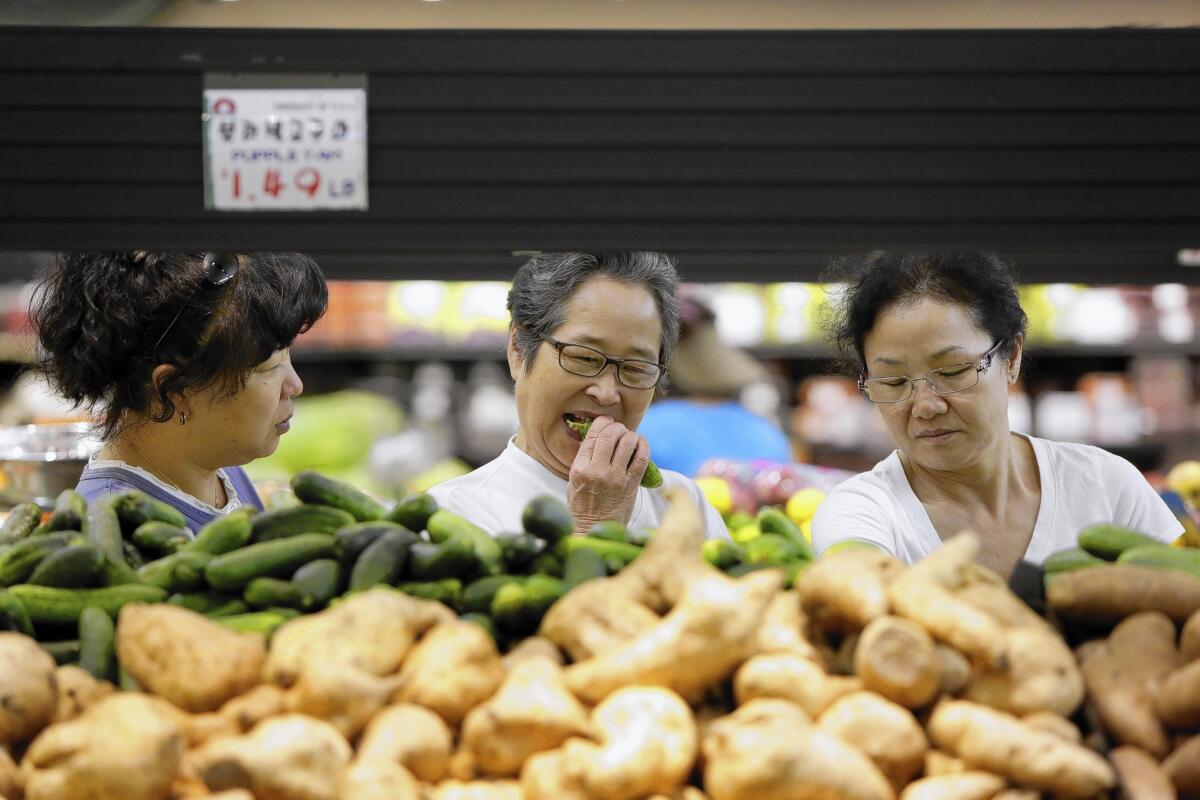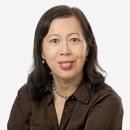Orange County home to third-largest Asian American population in U.S.

- Share via
When the Chinese School in Irvine opened in the 1970s as a home for teaching the native language and culture, only 30 students filled a handful of rented classrooms.
Now, it has its own campus — bursting with more than 1,200 students. It’s a reflection of the explosive growth of Orange County’s Asian population, which a new study now ranks as the third-largest in the nation, after Los Angeles and Santa Clara counties.
In a sprawling county of 3 million residents, today there are nearly 600,000 Asian Americans, marking a dramatic 41% increase from 2000 to 2010.
Orange County’s Asian communities also are developing differently from older ethnic enclaves. Rather than being dominated by one immigrant group, some of the area’s communities have a Pan-Asian feel, filled nearly equally with Chinese, Korean, Vietnamese and Japanese — often sharing shopping districts and neighborhoods.
Until recently, the county’s most visible Asian cluster was Little Saigon, a once-sleepy central district transformed by Vietnam War refugees into a bustling shopping and dining destination.
Since then, Asian American populations have spread north and south.
Orange County’s shift from a mostly white suburb to an ethnic melting pot is far from new. In 2003, whites lost their majority status amid a surge of Latino and Asian residents.
But these days, signs of Orange County’s diverse Asian population — which now includes Chinese, Korean, Vietnamese, Pakistani, Indian, Sri Lankan, Japanese and Bangdaleshi — is more visible than ever.
Affluent, master-planned Irvine has the county’s largest Asian population, at almost 43%, and is among the better-known hubs.
“New immigrants are well educated, they are more wealthy, so they can afford to choose which place is good for their family,” said Yulan Chung, principal of the Chinese School. “Irvine just happens to be the hot spot.”
Multiple languages echo from coffee shops and tutoring centers across the city, which boasts ethnic plazas such as the polished Diamond Jamboree — an oasis of pho shops, Korean barbecues, sushi and Japanese curry restaurants — and other Asian-specialty stores where shoppers can find ancient seaweed facial masks; luobo, a Chinese radish; and kabucha, a squash.
At the plaza’s most consistently busy spot, a Taiwanese bakery and cafe called 85 C, people lined up on a recent morning for fresh-baked brioche, squid-ink bread and shredded pork-topped buns.
Among them was Emma Navarro-Cruz, 55, who said the plaza’s diversity of Asian restaurants drew her to live in neighboring Tustin.
“I love Vietnamese food, and I love Thai, so when we came here I thought, ‘Wow, there are so many Asian restaurants in one place,’” said Navarro-Cruz, who is from the Philippines.
“A Community of Contrasts,” the study released last week, found that across the United States, Orange County now has the third-highest count of Asian American-owned businesses. The report also casts a spotlight on a tiny suburb many longtime Orange County residents might have trouble finding on a map.
Leafy, placid La Palma, spanning nearly two square miles in the county’s northwest corner, is O.C.’s first Asian-majority city, with Asian Americans constituting 51% of its nearly 16,000 residents.
“They are attracted to areas with good schools, good reputations and safe environments,” said Steve Hwangbo, a Korean-born councilman who has lived in La Palma since the 1970s. “We’re in Orange County but near the edge of L.A. County, and it’s so convenient.”
Here, Bank of America advertises to hire Korean-speaking staff; the city’s website is translated in Korean, Japanese, Chinese and Vietnamese; and the town’s biggest Asian store, a spotless Super 1 Mart, draws Asian Americans from neighboring towns. Inside, mini soccer balls hang from light fixtures, shelves explode with dozens of types of ramen, and workers restock soybean paste and soju, a popular rice liquor.
“You know why people are coming to O.C.? O.C. is famous,” said Janet Wu, whose son and grandsons moved to La Palma a year ago. “They read about it, they talk about it. You have so much choice for education around here. Who wouldn’t want to live in a place like this?”
Once known for its dairies and streets that rolled up at dark, La Palma now has a busy shopping district filled with Korean markets and diners and neighborhoods with tidy and sometimes elegant homes.
As much as any city, La Palma fits the Pan-Asian model. Though Koreans slightly outnumber other Asian groups, the town is a near-equal blend of Chinese, Filipino, Vietnamese and Japanese.
“It is like a big Asian family,” said Mike Song, owner of a Korean restaurant in nearby Stanton, who was loading up with pork belly and Shirakiku brown rice at the Super 1.
But the new demographic report, which relies mainly on data from the U.S. Census and other government sources, paints a picture more complex than one of suburban ease and comfort.
Between 2007 and 2012, for instance, the number of unemployed Asian Americans in the county jumped 123%.
Today, more than 57,000 O.C. Asian Americans are living at the poverty level, according to the study.
“We want policymakers not to look at Asian Americans as a homogeneous group,” said Kristin Sakaguchi, research analyst with Asian Americans Advancing Justice-Los Angeles, one of the groups that produced the report.
The Asian American population in Orange County has more recent immigrants than any other racial group, the data show, with 62% born outside the United States. About 38% have limited proficiency in English.
“The clear message in the study is that the changing population is not a footnote. It’s widespread — and O.C. is now not just known for Vietnamese Americans or Korean Americans. There’s huge growth for so many other Asian groups besides them,” said Karthick Ramakrishnan, a professor of political science and public policy at UC Riverside.
Bangdaleshi Americans, for instance, constitute the county’s fastest-growing Asian American group, jumping 118% in the last decade. Fijian, Sri Lankan and Pakistani American populations also grew significantly.
“Overall, the Asian American population is large enough and diversified enough that we can’t rely on our old assumptions about what Orange County is,” Ramakrishnan said.
For example, he said, Asian American clusters once considered reliably Republican now tend to lean to the left, leaving the political parties to redouble their efforts reaching out to ethnic voters.
In a sign of evolving demographic patterns, Asian Americans who settled in central O.C. started heading south as they became more affluent and assimilated, many of them drawn to neighborhoods around UC Irvine, where Asian American students constitute the majority. Others moved farther south to Lake Forest and Mission Viejo.
For Angi Ma Wong, a feng shui expert and intercultural consultant, the expanding Asian population in Orange County and elsewhere in Southern California has led to a thriving business.
Hoping to target Asian buyers, housing developers often seek her advice. She preaches basics, such as avoiding building stairs facing the front door. (Good fortune can’t get up the steps.)
She explains the logistics of Asian cooking, where big exhaust fans are useful to pull out the oil, smoke and steam. And she studies street addresses, to flag symbols of bad luck.
In recent years she has advised home builders developing the area around the Great Park, where large homes are built near smaller homes suitable for members of the extended family.
“The kids are just walking back and forth to Auntie’s house and Grandpa’s house after school,” Wong said. “They’re re-creating the family village.”
christopher.goffard@latimes.com
Twitter: @newsterrier
Twitter: @LATChrisGoffard
More to Read
Get the Latinx Files newsletter
Stories that capture the multitudes within the American Latinx community.
You may occasionally receive promotional content from the Los Angeles Times.








